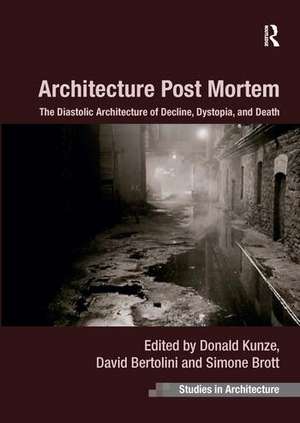Architecture Post Mortem: The Diastolic Architecture of Decline, Dystopia, and Death
Editat de Donald Kunze, David Bertolini, Simone Brotten Limba Engleză Paperback – 30 aug 2013
Preț: 448.86 lei
Nou
Puncte Express: 673
Preț estimativ în valută:
85.89€ • 89.92$ • 71.07£
85.89€ • 89.92$ • 71.07£
Carte tipărită la comandă
Livrare economică 07-21 aprilie
Preluare comenzi: 021 569.72.76
Specificații
ISBN-13: 9781409462224
ISBN-10: 1409462226
Pagini: 266
Ilustrații: Includes 27 b&w illustrations
Dimensiuni: 174 x 246 x 22 mm
Greutate: 0.44 kg
Ediția:New ed
Editura: Taylor & Francis
Colecția Routledge
Locul publicării:Oxford, United Kingdom
ISBN-10: 1409462226
Pagini: 266
Ilustrații: Includes 27 b&w illustrations
Dimensiuni: 174 x 246 x 22 mm
Greutate: 0.44 kg
Ediția:New ed
Editura: Taylor & Francis
Colecția Routledge
Locul publicării:Oxford, United Kingdom
Recenzii
Classified as 'Research Essential' by Baker & Taylor YBP Library Services A Yankee Book Peddler US Core Title for 2013 ’In the wake of global financial cataclysm and impending ecological catastrophe, architecture's role within the reproduction of contemporary capitalist relations has assumed a new urgency today. Collecting together a sparkling and adventurous series of essays, Architecture Post Mortem explores architecture's current confrontations with ruin, apocalypse and survival, in ways that provoke new political and theoretical questions at every turn.’ David Cunningham, University of Westminster, UK 'This collection of essays tracks the interaction of architecture’s literal and metaphorical deaths, says Jon Astbury ... there are some standout pieces, Simone Brott’s Dead or Alive in Joburg unpicks the 2009 film District 9 to reveal its parallels with South Africa’s urban realities and, consequently, the concept of violent urbanism'. Building Design Online
Cuprins
Introduction, DonaldKunze; Chapter 1 Driven into the Public: The Psychic Constitution of Space, ToddMcGowan; Chapter 2 Dead or Alive in Joburg, SimoneBrott; Chapter 3 Building In-Between the Two Deaths A Post Mortem Manifesto, NadirLahiji; Chapter 4 Kant, Sade, Ethics and Architecture, DavidBertolini; Chapter 5 Post Mortem: Building Destruction, Kazi KAshraf; Chapter 6 The Slow-Fast Architecture of Love in the Ruins, DonaldKunze; Chapter 7 Progress: Re-Building the Ruins of Architecture, GevorkHartoonian; Chapter 8, PeggyDeamer; Chapter 9 A Window to the Soul: Depth in Early Modern Section Drawing, PaulEmmons; Chapter 10, ErikaNaginski; Chapter 11 Architectural Asceticism and Austerity, DidemEkici; Chapter 12 900 Miles to Paradise, and Other Afterlives of Architecture, DennisMaher;
Notă biografică
Edited by Kunze, Donald; Bertolini, David; Brott, Simone
Descriere
Architecture Post Mortem surveys architecture’s encounter with death, decline, and ruination following late capitalism. As the world moves closer to an economic abyss that many perceive to be the death of capital, contraction and crisis are no longer mere phases of normal market fluctuations, but rather the irruption of the unconscious of ideology itself. Post mortem is that historical moment wherein architecture’s symbolic contract with capital is put on stage, naked to all. This collection includes essays by Kazi K. Ashraf, David Bertolini, Simone Brott, Peggy Deamer, Didem Ekici, Paul Emmons, Donald Kunze, Todd McGowan, Gevork Hartoonian, Nadir Lahiji, Erika Naginski, and Dennis Maher.









